Content [show]
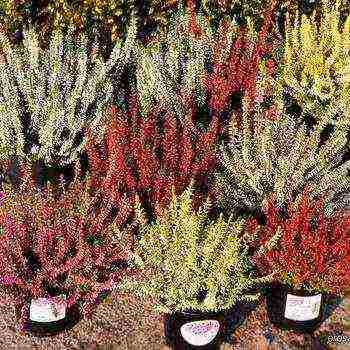 Growing heather in the garden is one of the easiest things a budding grower can do. A wide variety of varieties of common heather with flowers of various colors makes it possible to use this undersized shrub for composing compositions in different colors. Minimal maintenance is required for decorative heather, the main thing is to avoid trimming old wood in late autumn.
Growing heather in the garden is one of the easiest things a budding grower can do. A wide variety of varieties of common heather with flowers of various colors makes it possible to use this undersized shrub for composing compositions in different colors. Minimal maintenance is required for decorative heather, the main thing is to avoid trimming old wood in late autumn.
How to care for decorative heather in the garden
Landing features. The distance between plants is 0.3-0.4 m in groups or per 1 m2, 6-8 specimens of strong-growing and 12-15 weak-growing varieties are planted. Planting depth 25-35 cm strictly to the level of the root collar. It is better to plant in open sunny places at the age of 1.5-2 years, when the plants have the greatest decorative effect. For planting and successfully growing heather, it is better to use a soil mixture of the following composition: peat, sand, bark compost or coniferous soil (3: 1: 2). Coniferous land is a semi-decomposed litter of a coniferous forest, spruce or better pine, it is taken from a depth of 5-7 cm.The substrate must be acidic (pH = 4.5-5.5), therefore, red high-moor peat is used (pH = 3.2 ). Planting time: second half of April - early May or autumn in late September - early October. Dry weather is not an obstacle to planting if the plant is pre-watered abundantly. Drainage is needed if the soil is clayey, and consists of sand and broken brick with a layer of 5-10 cm.
Top dressing. When growing and caring for heather, it is recommended to annually feed the complete mineral fertilizer "Kemira Universal": 1 tablespoon per 10 liters of water. When planting, 1 matchbox of nitrophoska and 2 tablespoons of horn flour for low-growing varieties of heather and 2 matchboxes of nitrophoska and horn flour for vigorous varieties are added to the substrate.
Mulching. A necessary condition for growing heather is mandatory mulching immediately after planting with peat or coniferous wood chips, since it contains the necessary mycorrhiza.
Pruning. Pruning is done in moderate spring. Intensive pruning is not recommended for the first two years after planting. After flowering in autumn or early spring, old plants are cut with pruning shears so as to capture part of the stem below the faded inflorescences. In the process of caring for decorative heather, it is necessary to maintain the shape of the crown when pruning. Avoid pruning old wood in late fall when some heathers are cut for winter bouquets.
Preparing for winter. When growing and caring for heather in the garden in late autumn, when the soil is 5-7 cm frozen (about November 10), it is recommended to sprinkle peat or a dry leaf with a layer of up to 10 cm on top of the plant. In mid-April, the shelter must be removed, the peat must be removed from the root collar in order to ensure full flowering of the heather.
The photo "Growing and caring for heather" shows all the main agricultural techniques:
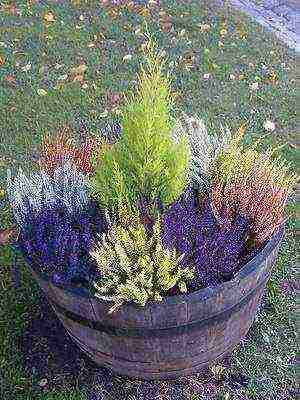
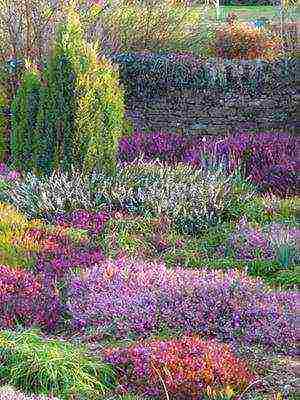
Common heather varieties for open ground in the Moscow region (with photo)
Heather (Calluno) is a plant from the Heather family.Common heather (C. vulgaris) is a low-growing shrub, 20-70 cm tall. The crown is quite compact, almost round.
As you can see in the photo, the heather shrub has flowers on short pedicels, several pieces are collected in dense racemose inflorescences up to 25 cm long, lilac-pink, rarely white:
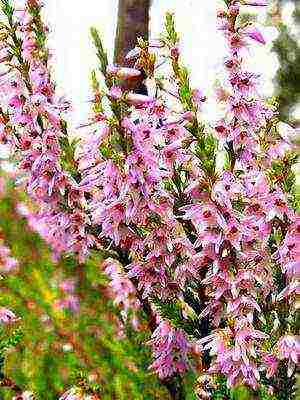

Flowering time: July August. Photophilous, withstands weak partial shade. It hibernates without shelter, it is quite winter-hardy. For cultivation in the gardens of central Russia, the best varieties are:
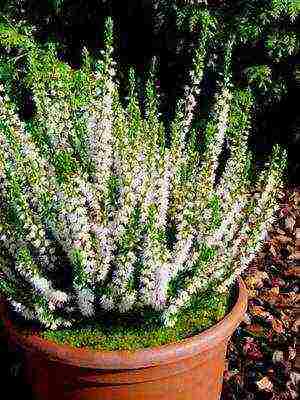
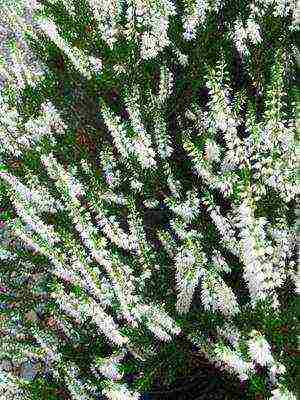
"Alba Plena" ("Alba Plena") - a low evergreen shrub 20-40 cm high, with a crown diameter of 40-45 cm. The crown is compact, spherical. The flowers are white, double. Decorativeness manifests itself during abundant and prolonged flowering, in August-September, 50 days. Winter-hardy. It is better to cover young plants with a dry leaf and spruce branches for the winter.
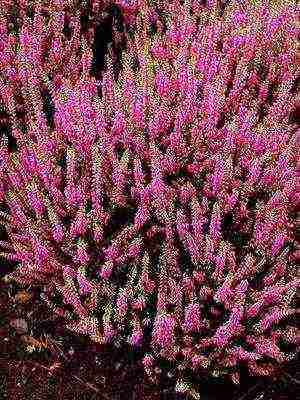
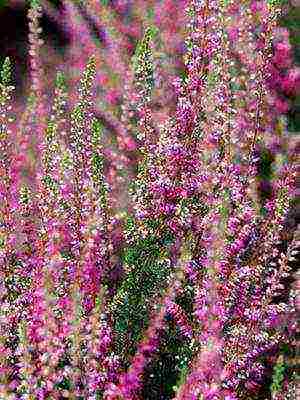
"Allegro" ("Allegro") - height 40-50 cm, rarely 60 cm, crown diameter 50 cm. The crown is compact, dense. Blooms in the suburbs from early August to late September. The flowers are simple, shiny, carmine red. Winter-hardy.
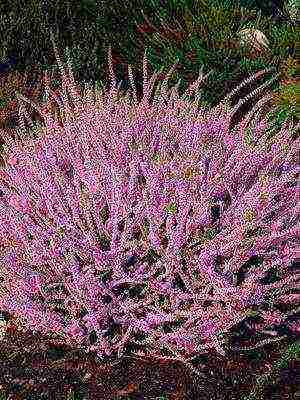
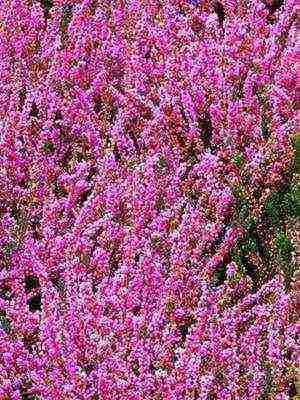
"Annemarie" ("Annemarie") - height 40-50 cm, crown diameter 60 cm. The crown is loose, wide-bushy. Blooms from late July to late October. The buds are purple-red, later the flowers become dark pink. Terry flowers.
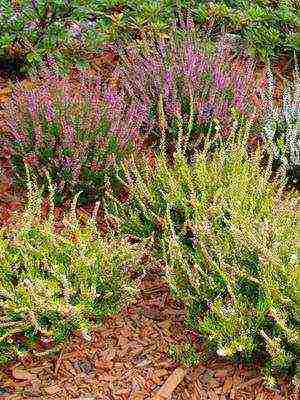
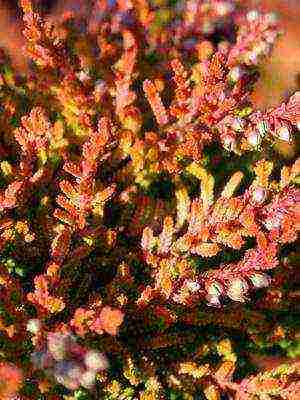
"Boskop" ("Boskoop") - height 30-40 cm, crown diameter 40-50 cm. The crown is compact. Leaves are coppery orange-red in autumn and winter. Outdoors, this heather variety blooms from August 25 to late September. The flowers are lilac-pink, simple.
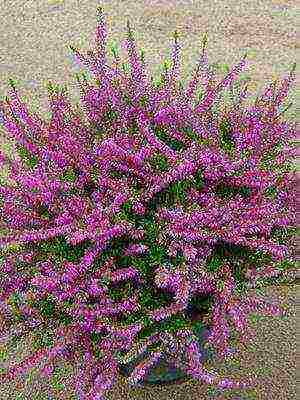
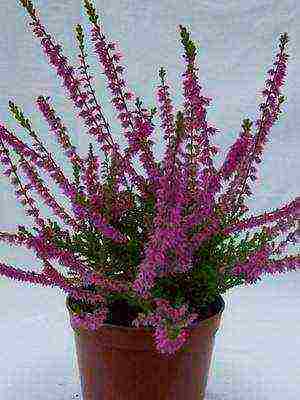
"Carmen" ("Carmen") - height 30-40 cm, crown diameter 40-50 cm. The crown is broadly oval or spherical. Blooms in Moscow from early September to mid-October, 45 days. The flowers are simple, pink-purple.
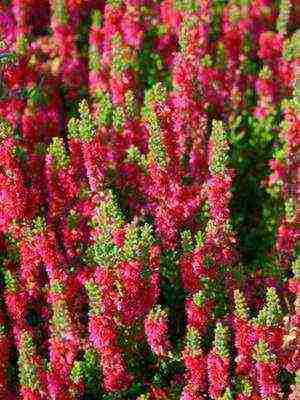
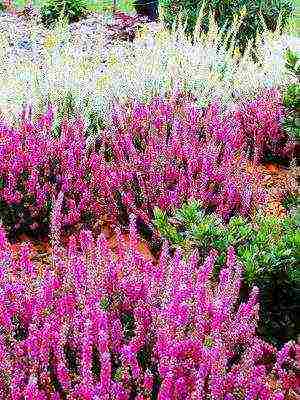
"Darkness" ("Darkness") - height 30-35 cm, diameter of a compact, dense, spherical crown 40-50 cm. It blooms from late August to mid-October, abundantly, about 50 days.
Look at the photo - the decorative heather of this variety has simple, purple-red flowers, densely located on peduncles up to 15 cm long:
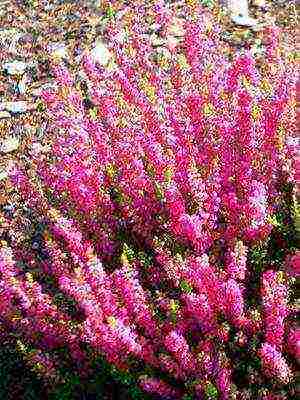
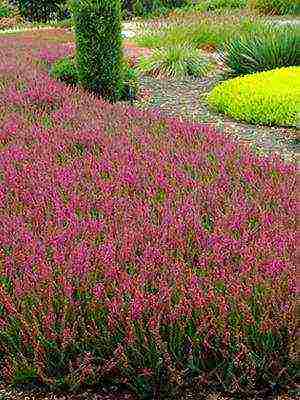
"Dark Star" ("Dark Star") - height 20-30 cm, crown diameter up to 40 cm. The crown is compact, spherical. Blooms profusely from late August to late September, 30 days, rarely until early October. The flowers are semi-double, ruby red, shiny. Weak bush, annual growth of 3-5 cm.
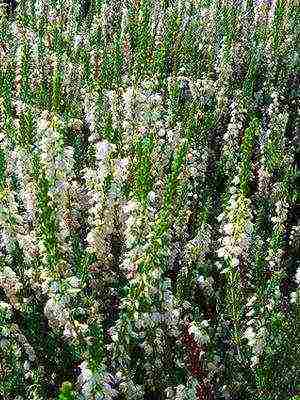
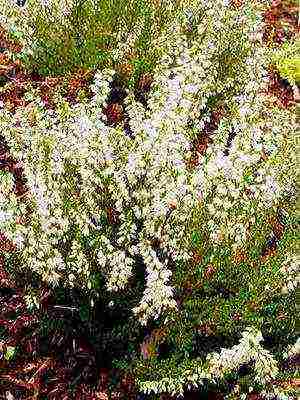
Long White ("Long White") - height 40-60 cm, crown diameter 60-70 cm. The crown is loose, spherical. In Moscow, it blooms profusely from late August to early October, 40 days, in Europe - from September to late October. The flowers are white, simple, collected in long inflorescences (25-30 cm).

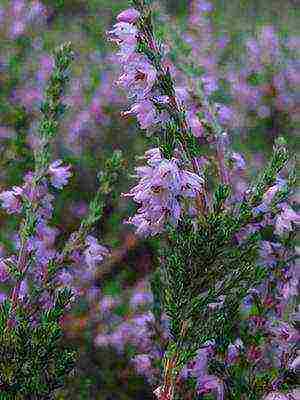
"Marlin" ("Marleen") - height 20-30 cm, crown diameter 40-50 cm. The crown is compact. In Moscow, it blooms profusely from late August to late October, 65 days, in Europe, September-November. The buds are pink-lilac or bright purple, never open.
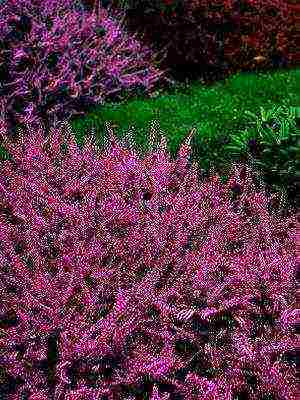
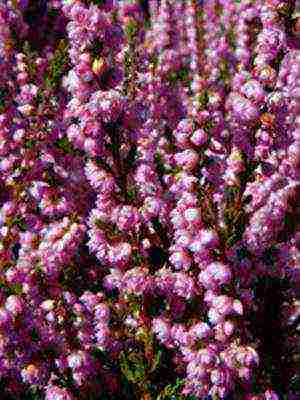
Peter Sparks ("Peter Sparkes") - height 40-50 cm, crown diameter 50-60 cm. The crown is oval. This variety of heather in the Moscow region blooms from early September to late October, 55 days, abundantly, in Europe - in September-November. The flowers are double, dark pink.
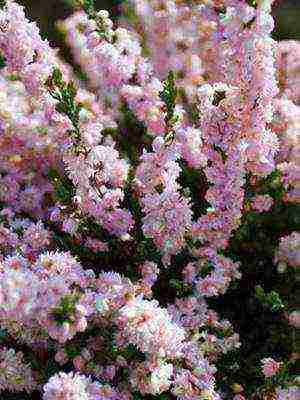
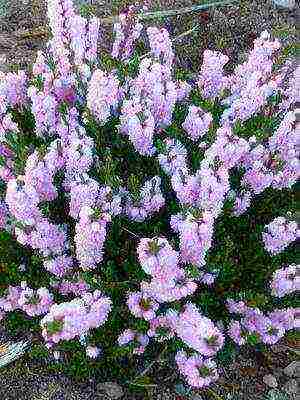
"Radnor" ("Radnor") - height 20-30 cm, crown diameter 40-50 cm. The crown is compact. Blooms in the suburbs from August 20 to mid-October, about 50 days. Terry flowers, pale pink, collected in inflorescences 10 cm long.
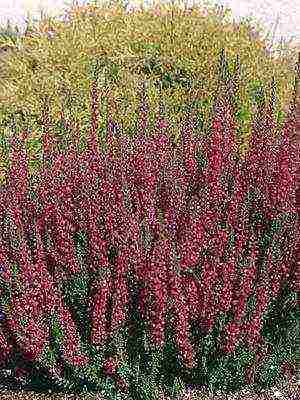

"Red Star" ("Red Star") - height 20 cm, crown diameter 40-50 cm. The crown is compact, spherical. Blooms in the suburbs from mid-September to early November. Double flowers, red. Densely located on long (more than 10 cm) inflorescences. Profuse and late long flowering, 48 days. A very beautiful variety.


Silver Knight ("Silver Knight") - height 20-30 cm, crown diameter 40-45 cm. The crown is compact, pillow-shaped. In winter, the leaves take on a purple hue. Very beautiful foliage. Blooms profusely in the Moscow region from mid-August, about 45 days. The flowers are simple, light purple or lilac.
As shown in the photo, at the heather of this variety, the tops of non-flowering shoots are drooping:
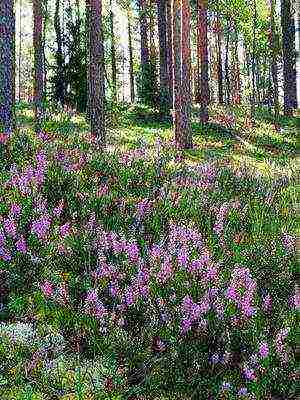
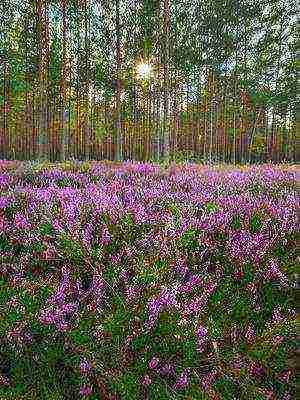
The garden centers are currently receiving varieties from the Garden Girls and Beauty Ladies series. These plants are interesting because their buds never open.
Where does blooming heather grow (with photo)
Heather (Calluna, Russian transcription - Calluna) belongs to the Heather family, its homeland is Asia, North Africa, Greenland, America.
The Latin name for heather comes from the ancient Greek verb "kalynein" - "to clean", which is explained by the functional purpose of the plant, the bundles of which were used to clean the room like a broom. Heather comes from the heather family and is the closest relative of the rhododendron, despite the complete lack of external similarity between the two species.
Look at the photo - the leaves and flowers of the heather plant are so small and numerous that from a distance the heather thickets resemble light curly clouds:
Heather is common in the western Mediterranean, in the mountains of eastern Africa, Arabia and Asia Minor, Madeira and the Canary Islands. A related species E. azorica - Azores heather grows in the Azores. Where heather grows in its natural habitat, over the years the bush grows up to several meters in height. Its orange-brown trunks are intertwined. Fire resistant root wood is used to make smoking pipes. In a pot or tub, Erica grows very slowly, but blooms extremely profusely in early spring, when the stems are literally strewn with countless tiny white flowers.
Common heather plant (C. vulgaris) is an evergreen undersized shrub 30 - 70 cm tall, with rigid, erect stems. Differs in extreme undemanding to soil conditions. Has a beautiful compact crown. The leaves are small, tiled-needle-like, without petioles, similar to the needles of spruce, up to 2 mm long.
As you can see in the photo, blooming heather is a lilac-pink or carmine-red thickets:
The flowers of the plant are shiny, small, similar to bells, collected in one-sided racemose inflorescences. It blooms late - in late summer, and more often in early autumn. Heather fruits are capsules containing many small seeds.
In central Russia, the shrub requires protection from frost: the plant should be covered with spruce branches or dry leaves. You need to plant heather in bright sunny areas. Requires acidic soils (pH 4.5-5.5).
Pay attention to the photo - heather flowers are most often planted together with the plants with which it grows side by side in the wild: juniper, cotoneaster, broom, erika:
Often, group plantings of heathers are arranged under tall trees with a sparse crown, which sufficiently transmits the sun's rays. On the border of the heather thickets and the rest of the rocky garden, unpretentious and undemanding perennial plants are planted, smoothing the abrupt transition and creating the illusion of an integral garden space.
Common heather (Calluna vulgaris) naturally blooms with pinkish-purple flowers. However, in decorative floriculture, wild heather is usually not used, giving preference to its cultivated varieties and varieties with a wide variety of flower colors.
Heather varieties and photos of its flowers
Here you can find photos and descriptions of the most popular heather varieties.
1. Allegro - an evergreen plant 40-50 cm high with a small dense crown 50 cm in diameter. Leaves are dark green in color. It blooms profusely every year from the beginning of August until the end of September with shiny red flowers, collected in long, up to 30 cm in size, unbranched inflorescences.
2. Annemarie is an upright shrub 40-50 cm high, with a crown 60 cm in diameter. In autumn, the leaves of the bush are dark green in color, in winter and spring they turn gray-green. They are small, up to 2 mm long and 0.6 mm wide, resembling scales. This variety of heather blooms from late July to late October, especially plentifully in September with double flowers, which gradually change from one color to another. The purple-red buds become dark pink as they unfold.Long, up to 20 cm, inflorescences look decorative.
3. Boskop - a plant that forms a bush 30–40 cm high. It has a compact crown 40–50 cm in diameter with branches pointing upwards. This heather variety has very beautiful leaves, yellow-green in summer and orange-red in autumn. Young plants of this variety of common heather have a brighter color of leaves than old ones. It blooms profusely from late August to early November with light lilac flowers, collected in inflorescences about 10 cm long.
4. Long White - one of the tallest varieties of this species, reaching a length of 60–70 cm. Its shoots grow upward.
As shown in the photo, common heather of this variety has a loose spherical crown with a diameter of 50 cm and small leaves of bright green color:
Blooms profusely from late August to early November with white long clusters.
5. Silver Knight is a dense shrub 20-30 cm high, with a compact crown 40 cm in diameter, cushion-shaped. In summer, the leaves of the plant are silvery, purple in late autumn. Blooms from August to early October.
Look at the photo - this variety of heather blooms with light purple flowers that adorn the bright red stamens:
Sometimes flowering continues until the first snow falls.
In garden design, heather is planted in the foreground of the site, along the paths, and parterre places are made out for them. Tall bushes, such as rhododendron, or conifers can serve as a background. Heather can also be planted on alpine slides and decorated with curbs.
Tall (50 cm) "Alba Erecta" and miniature (10 cm) "Pumile" with white non-double flowers,
spreading "Alba Plena" with erect stems and white double flowers,
tall (50 cm) Alportii with erect stems and bright purple-red flowers,
undersized "Camla" with pink double flowers,
undersized "Country Wicklow" with double light pink flowers,
unusually spectacular "Cuprea" with bright yellow-green foliage, which turns red-brown in winter, and light purple non-double flowers,
large "N. E. Beale " with erect stems and pink double flowers with a white center, collected in long cluster-shaped inflorescences,
J. N. Hamilton " with yellow-pink double flowers,
compact "Mullion" with densely branching stems and dark pink flowers.
Most varieties bloom in August-September. Alba Plena and Pumile bloom until frost. Many varieties do not lose their attractiveness even in winter.
Growing conditions, planting and caring for heather outdoors
When planting, for ease of caring for heather in the open field, a distance of 30–40 cm is left between the bushes. The planting depth is 25–35 cm. The plant takes root better in open sunny areas at the age of two years. The substrate is prepared from peat, sand, bark compost in a ratio of 3: 1: 2. The soil must be acidic. Therefore, for its preparation, peat with an acid-base balance equal to 3, 2 is used. Planting is carried out in late April - early May or in autumn, in late September - early October.
One of the main conditions for growing heather is the presence of humus-rich sandy soils with an acid reaction, high peat content. At the same time, heather does not tolerate excess lime. Heather thickets grow rapidly, filling the rocky slopes, so it is not customary to arrange them in a small garden area. This plant needs space! And if it is enough, then you will not regret that you planted heather on your site. At the same time, it is recommended to plant large areas with one variety of heather or several varieties that form flowers of the same color. Thanks to the dense and extremely picturesque heather thickets, your site will turn into a fabulous corner until autumn.
When planting and caring for common heather, do not forget that this plant is extremely light-requiring. It reacts to a lack of lighting with poor flowering and slow growth. In this case, the shoots are stretched and thinned. Heather thickets practically do not require special care, even with weeds you will not have to fight, since the heather will displace them on its own, without human help. In this case, you will only have to make sure that the heather does not crowd out its cultural neighbors. Therefore, the stems of faded plants are shortened, and old individuals are cut from time to time in the spring. Occasionally, heather thickets are sprinkled with peat. During the growing season, heather needs abundant watering. The rest of the time, the plant tolerates the lack of moisture well enough. In a dry, snowless winter, when growing heather, the plant needs shelter, in other cases, although it freezes under sub-zero temperatures, it quickly recovers with the onset of warm weather.
Heather reproduces by layering and dividing the bush (in spring), as well as by semi-lignified cuttings, cut before budding, in a cold greenhouse (in summer).
Growing and caring for heather is carried out in slightly acidic, humus-rich soil, which must be evenly moistened in summer. Heather loves warmth and sun, as well as fresh air. Therefore, it is recommended to keep it outdoors and not in a greenhouse. In winter, however, it must be brought into the room. But even here, in a cold and very bright place, he needs ventilation. Keep the temperature below 15 ° C, otherwise the heather will start to grow and, accordingly, will not bloom in the spring. During this time, water sparingly, but do not allow the soil to completely dry out.
Common heather bushes are planted in a conspicuous place in the garden, they make good curbs. Some varieties of heather can also be used as ground cover plants on alpine hills, near large stones, near small bodies of water. Blossoming branches serve as delightful bouquets. Heather should be planted in sunny areas, sheltered from the wind. The best varieties of heather for the Moscow region are: ‘Allegro’ - carmine-red flowers, ‘Long White’ - pure white flowers, as well as ‘Marlene’, ‘Annemaria’, etc.
When caring for heather, plants generally need a little pruning. The first 2 - 3 years after planting heather in a permanent place, pruning is not carried out at all. Only broken and diseased branches are removed, as well as branches that interfere with obtaining a compact bush. At an older age, they carefully break off the faded flowers with their hands in order to prevent the setting of seeds.
As shown in the photo, when caring for heather, the tops of the shoots are removed annually with scissors:
In old plants, after the end of flowering, part of the stems located below the faded inflorescences are cut out with garden scissors, while capturing damaged and diseased shoots.
Try to keep the shape of the bush when pruning. Bushes with such pruning become more compact and dense. Pruning and shaping is best done in the spring.
Check out the photo of heather care for a better understanding of how to care for this plant:
The herbaceous evergreen plant common heather (Calluna vulgaris) is the only species of the genus heather belonging to the heather family. Today there are about 500 varieties of this plant, most of which have very high decorative qualities. Under natural conditions, the plant is found in Europe (spreads from the zone of coniferous-broad-leaved foxes to the tundra), in North Africa, in Greenland, in the temperate latitudes of Asia, in the Azores, on the Atlantic coast of North America, while it prefers to grow in peat bogs, burnt places and forests.An old Scottish legend says that of all plants, only heather agreed, at the request of the Creator, to grow on rocky bare hills that are blown by all winds, for which he was awarded unpretentiousness, endurance, good aroma and charming appearance. And today, in those places where heather grows, there is no other plant anymore. Sometimes it occupies huge areas, which are called heather wastelands. Veresk gave the name to September in Belarusian, Ukrainian and Polish, namely: Veresen, Verasin, wrzesien.
Features of heather
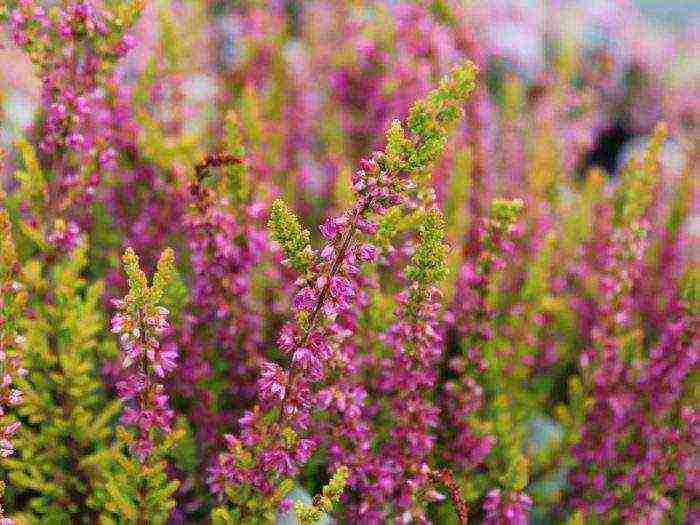
Heather is a strongly branching evergreen creeping small shrub 30–70 centimeters high. Small leaf plates that are triangular, as if rolled into a tube. Small fragrant flowers that look like bells are painted in lilac-pink color. They are part of the one-sided brushes. Flowering begins in the second half of the summer period, however, such a plant becomes the most beautiful after the onset of the first frost, because its leaves at this time are painted in burgundy and yellow. Robert Louis Stevenson wrote the whole heather ballad, Heather Honey. Such a plant is an excellent honey plant, while heather honey is considered the most useful of all. Landscape designers use heather to decorate alpine slides, plant it along paths in the garden, and use it to create borders that look very impressive against the background of dwarf conifers.
Growing heather from seeds
Sowing seeds
To grow heather from seeds, you need to be patient, because this process is quite long and difficult. However, it may please you that heather seeds have an excellent germination rate, namely, 90 percent. The dish must be filled with earth mixture and moistened. Spread the seeds over its surface, but you do not need to bury them. Cover the container with glass and wait for seedlings. For sowing seeds, it is recommended to use a substrate consisting of sand, coniferous soil and peat, which are taken in a 1: 1: 2 ratio. Crops need to be put in a warm place (about 20 degrees), while in the first 7 days the seeds need an increased level of moisture. The first shoots appear after 4 weeks. Immediately after the appearance of seedlings, they should be hardened. To do this, you should open the shelter for a while. After the seedlings grow strongly, a pick should be made, they are planted in individual pots or transplanted into a container.
Seedling care
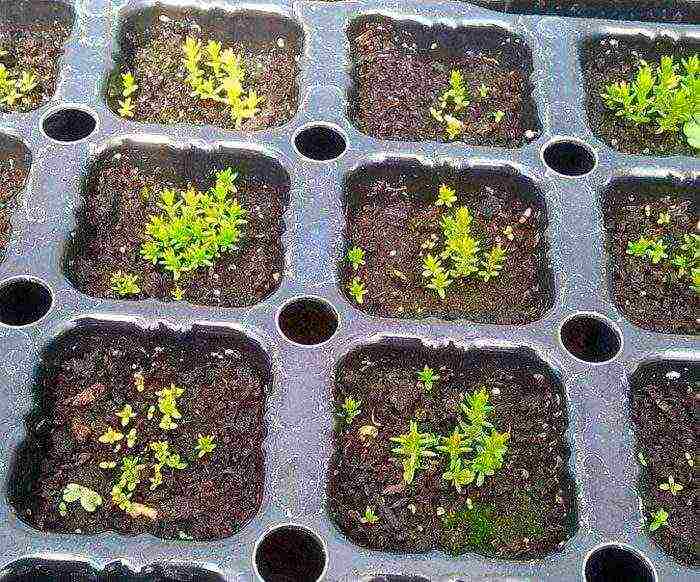
In the summer, the seedlings should be transferred to the garden and placed in a semi-dark place, while they should be systematically watered. When it becomes cold outside, the seedlings are transferred to a cool room (about 10 -12 degrees).
It is possible to plant heather in a permanent place only at the age of two. Remember that seed-grown heather is not capable of retaining the characteristics of the parent plant. However, as a result of your labors, a completely new variety may appear.
Planting heather in open ground
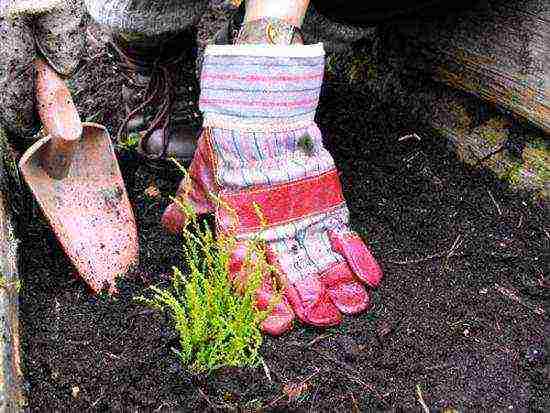
Where and at what time do they disembark
Experienced gardeners recommend planting heather in the spring, namely, from the second half of April to the first days of May, you can do this in the fall - from the end of September to the first days of October. For planting, it is better to choose open, well-lit areas, but you can plant this plant in partial shade. Peaty wet soils or dry sandy soils are best suited for it. It is impossible to plant this flower in limestone soil. It's okay if the soil contains few nutrients, but the pH must be 4.5–5.5. Heather will grow best in soil consisting of sand, peat, bark compost (coniferous soil), which should be taken in a 1: 3: 2 ratio. The area where the heather is grown must be protected from gusts of wind.To acidify the soil, it is necessary to add red high-moor peat to it.
How to plant
Depending on the variety, 6 to 10 seedlings are planted on a 1 square meter plot. The bush should be buried 25–35 centimeters into the soil, while the root collar should be flush with the soil surface. If the soil is clayey in the planting hole, it is necessary to make a drainage layer consisting of sand or brick fragments, while its height should be from 5 to 10 centimeters. Also, horn flour (30-50 grams) and nitrophoska (20-30 grams) should be added to each hole. The planted heather is watered at the rate of 5–6 liters of water per 1 bush. The surface of the site must be sprinkled with a layer of mulch (coniferous chips or peat). Remember that this plant does not tolerate transplanting very well, so you need to immediately choose the optimal place for planting it and take good care of it so that you do not have to transplant it.
Care features
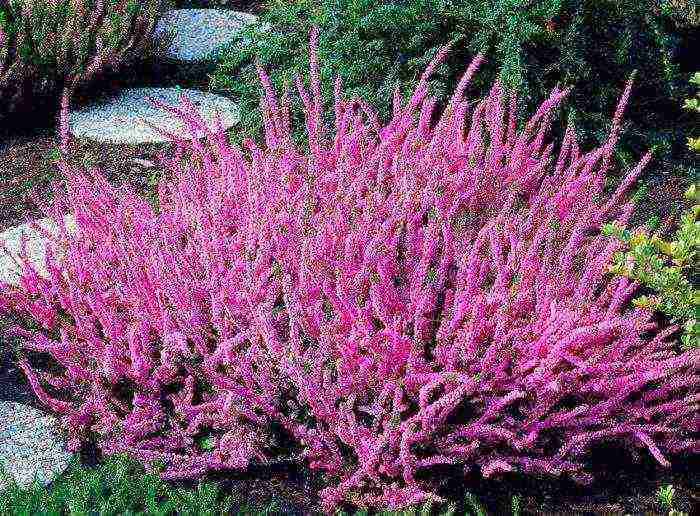
The root system of heather is not long, so it needs to be watered regularly if there is no systematic precipitation, while acidified water is used. Please note that the surface of the soil on the site should be constantly slightly moistened. In this regard, the surface of the soil must be covered with a layer of mulch. Also, mulch does not allow the soil to heat up very much on hot days. Water the heather every 10-15 days. After watering is done, you need to loosen the soil to a depth of 10 to 15 centimeters, while you need to pull out all the weeds. It is necessary to loosen and weed the ground through the mulch. In hot times, this plant can suffer from excessively dry air, therefore it is recommended to humidify it from a sprayer every evening. Do not forget to feed the plant every year in springtime (in April or May), while full mineral fertilizer is applied to the soil, 1.5–2 large tablespoons of fertilizing are taken per 1 bush (1 square meter takes from 20 to 30 grams). In this case, dry fertilizer must be carefully scattered over the area, try to prevent the substance from getting on the foliage and flowers of the plant, otherwise a burn will form on their surface. After that, the top dressing must be sealed in mulch, and the soil must be watered abundantly. Every spring, it is necessary to prune, which performs a formative function, and also stimulates the growth of young shoots. At the same time, intensive pruning can only be done when 3 years have passed since the moment the heather was planted. Try to keep the shape of the crown. Cutting rule: the inflorescence with the left hand must be held by the upper part, and with the right hand - you need to cut off ½ or 2/3 of the inflorescence part. The cut pieces can be finely chopped and sprinkled over the top of the mulch.
Pests and diseases
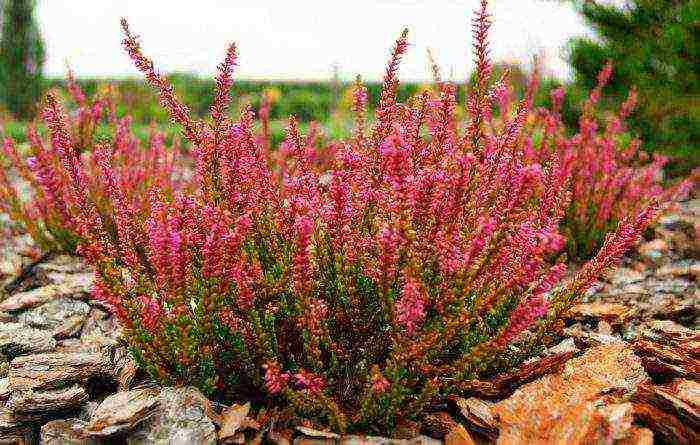
This plant is highly resistant to harmful insects and diseases, but sometimes it is affected by viral or fungal diseases. Often, heather gets sick with gray rot. The development of this disease can be caused by poor water permeability of the soil, either due to the fact that in spring the snow cover melts too quickly, as a result of which the liquid stagnates in the root system. In an infected specimen, plaque appears on the stems, then the leaves and the shoots themselves die off. To combat the disease, the treatment of the plant with fungicidal agents is used, and Topaz and Fundazol cope best with this disease. If the bush is very badly affected, then treatment with a solution of copper sulfate (1%) will be required. It is necessary to process heather 3 times with intervals of 5-10 days. For prevention purposes, the plant is treated in spring with fungicides immediately after the shelter is removed from it. It is also necessary to spray the bushes in the fall during preparation for winter.
If the bush is infected with powdery mildew, then young shoots begin to fade, and a whitish loose bloom appears on the leaf plates.If brown-red spots appear on the leaves, this means that the heather is infected with rust. These two diseases are fungal, like gray rot, so they are fought with fungicidal agents.
If the bush is struck by a viral disease, then its flowers or stems may become deformed, and the color of flowers and leaves becomes uneven, it becomes uncharacteristic for this variety. This disease cannot be cured; therefore, the affected plants must be dug up and destroyed. The area where they grew must be watered with a very strong solution of potassium manganese.
In the event that a plant is grown on soil that suits it and receives the necessary care, then it is unlikely to get sick.
Heather propagation

How to propagate this plant by seeds is described above. Heather can also be propagated by layering, dividing a bush or by cuttings. At the end of the summer period, you need to cut off the apical cuttings, while they are taken from the strongest flowering branches. For rooting, they are planted in pots filled with a mixture of peat and sand (3: 1). They need to be placed in a cool place (from 15 to 18 degrees), while the soil should be constantly slightly damp. Once every 1.5–2 months, cuttings need to be fed, for this they use a solution of urea (1 gram of substance per 1 liter of water) or micronutrient fertilizer. In springtime, rooted plants are transplanted into open soil.
Heather is often propagated by layering on its own. Over time, old branches of heather will lodge on the surface of the soil and give rise to roots. In order to obtain a cut, it is necessary to bend the mature stem located at the very bottom and fix it on the surface of the earth. Then it is covered with a layer of peat, the thickness of which should be 10 mm. After 12 months, it will be necessary to separate the layers and plant it in a permanent place.
Heather is most simply and easily reproduced by dividing the rhizome. This procedure is carried out at the end of the summer period. To do this, you need to dig a mature bush. It is not necessary to remove the soil from the roots, they are cut into several parts so that each of the divisions has roots and young growth. Before planting the cut, you should cut off the old stems. They are planted immediately in a permanent place in different holes, and do not forget to sprinkle the cuts with crushed coal.
Heather after flowering
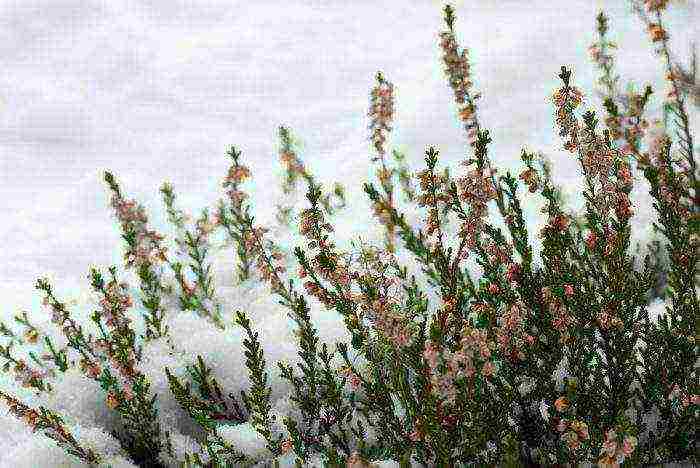
In regions with warm climates, this plant perfectly tolerates winter without shelter. But in the event that the winters are harsh and little snow, it is better to prepare the heather for wintering. When frosts come, the surface of the site must be sprinkled with a layer of peat, and then the heather itself should be covered with spruce branches, which will protect the plants from frost and sunburn in spring. It will be necessary to remove the shelter in April.
Main types and varieties with photos and names
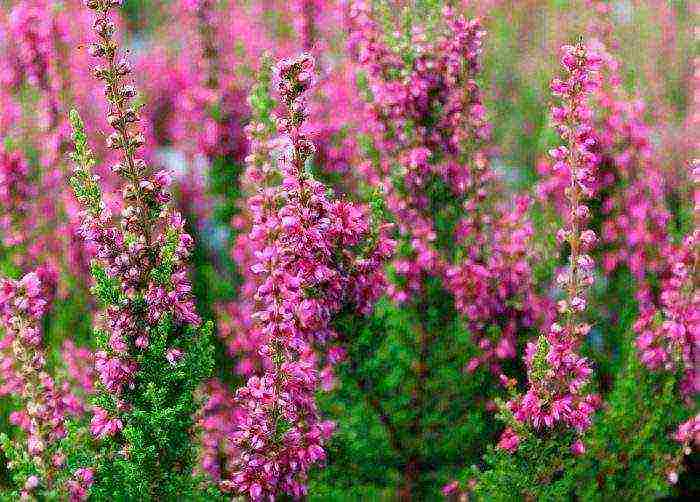 Common heather
Common heather
Common heather (Calluna vulgaris) - this is the only species in the genus. Erica is often considered heather, which is closely related to this plant. However, heather and erica are different plants. The common heather has a huge number of excellent varieties, currently there are about 500 of them. Gardeners divide all of these varieties into 6 different groups.
1 group. Varieties with green foliage
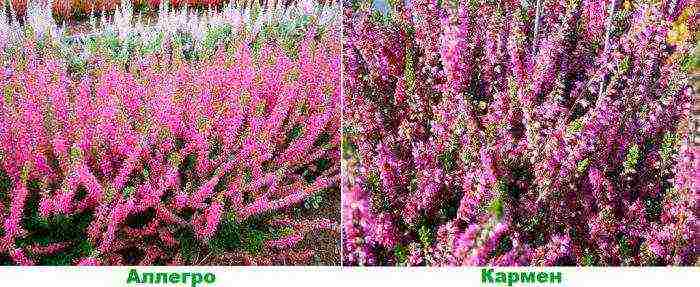
- Allegro... The height of this evergreen shrub is about 0.6 m, and its crown has a diameter of about 0.5 m. There is a compact, rather dense crown, dark brown bark and scaly leaf plates of a dark green color. Flowering is observed from the last days of July to the end of October. Red-carmine flowers are simple glossy, they are collected in long inflorescences. The plant is winter-hardy, only young bushes need to be covered for the winter.
- Carmen. This hybrid variety, bred in Holland, is very popular in European countries.The bush reaches 0.3–0.4 m in height, has a rounded crown, small dark green leaves, dark brown bark, simple pinkish-purple flowers, which are collected in peduncles (up to 10 centimeters long). Hardy, but needs shelter during the winter.
And also popular are such varieties as: Radnor, Duckness, Ross Hutton, Mazurka, Marco, Barnett Anley, Hookstone, etc.
Group 2. Varieties with white flowers and green leaf plates
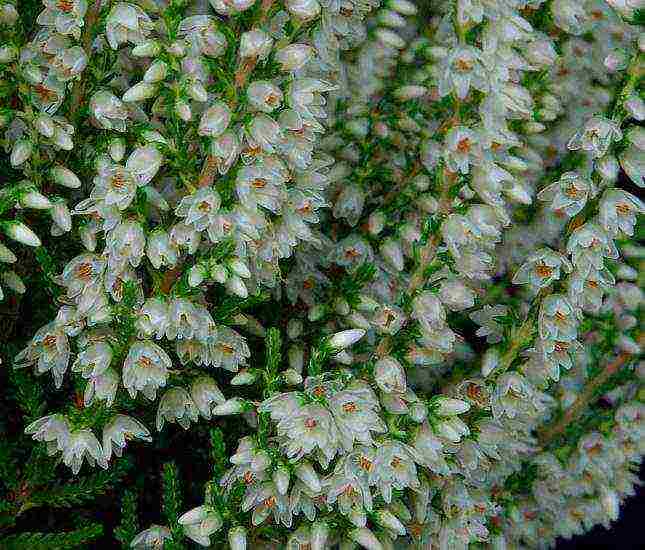 Alba
Alba
- Alba... The height of the erect bush is about 0.4 m, while the crown has a diameter of about 0.55 m. On the ascending branches are rich green leaf plates. White flowers are collected in dense racemose inflorescences.
- Alexandra... The spherical bushes reach 0.3 m in height, while the crown diameter is 0.4 m. The leaf plates are dark green in color, and the flowers are pale cream, while by the end of flowering they turn dark red.
Also popular are such varieties as: White Lone, Humpty Dumpty, Long White, Alec Martin, Alba Jay, etc.
Group 3. Varieties with silvery foliage
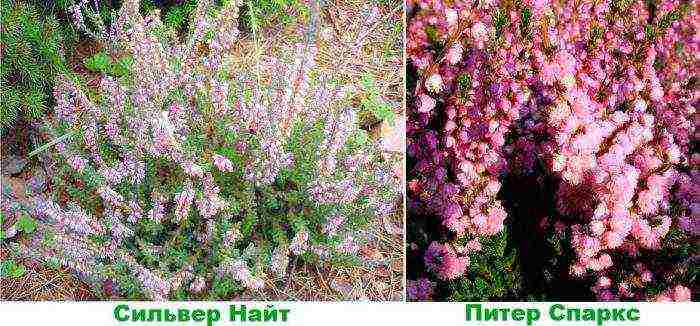
- Silver Knight... This variety is bred in England. The height of the bush is about 0.3 m, and the diameter of the compact cushion crown is 0.45 m. The bark is dark brown, grayish-silvery leaf plates are pubescent. In winter, the leaves turn burgundy. Simple lavender or lilac flowers are collected in inflorescences having a length of 20 centimeters. It is resistant to cold, but it needs to be covered for the winter.
- Peter Sparks... The variety is also obtained in England. The height of the bush is about 0.5 m, and the diameter of its oval crown is 0.6 m. The bark is dark brown, small scale-like leaves are dark green in the summer-autumn period, and greenish-gray in the winter-spring period. Terry dark pink flowers are part of inflorescences, the length of which is 0.3 m. Possesses moderate frost resistance.
Also popular are such varieties as: Annmarie, Velvet Fashion, Jan Decker, Glendwick Silver, etc.
4 group. Varieties with golden foliage
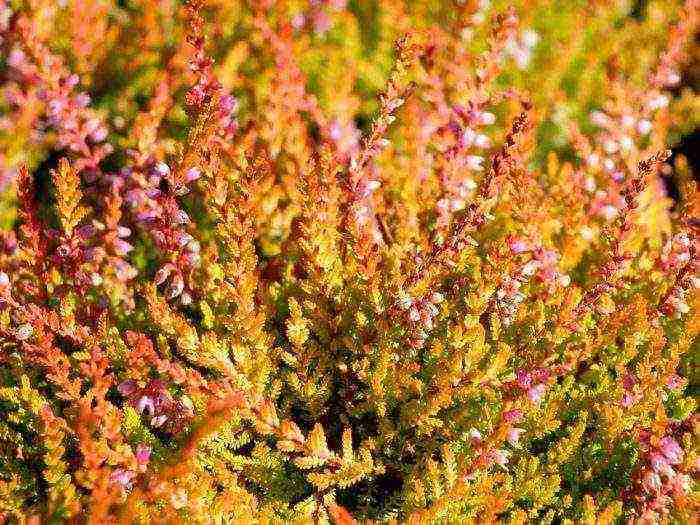 Boskup
Boskup
- Andrew Proudley... The bush reaches a height of 15 centimeters, while the diameter of its crown is about 25 centimeters. The broad ascending branches are rather thin. In the warm season, the foliage is orange and has light yellow tips, and in the winter it turns bronze. Small pink flowers are part of loose inflorescences.
- Boskup... The variety was created in Holland. The bush reaches a height of 0.4 m, and the diameter of its compact crown is 0.5 m. The bark is dark brown. In summer, the leaf plates are greenish-yellow, and in autumn they turn reddish-copper. Simple lilac-pink flowers are part of short, low-branched inflorescences, which reach about 10 centimeters in length. Possesses moderate frost resistance.
Other popular varieties are: Aura, Arran Gold, Blazeway, Crimson Sunset, Gold Hayes, Cottswood Gold, etc.
5 group. Varieties with double flowers
- Autumn Glow... The height of the spreading shrub is about 0.3 m, and the diameter of its crown is about 0.45 m. The ends of the branches are raised. Dark green leafy plates, lavender densely double flowers are part of short, rather dense racemose inflorescences.
- Monica... The height of the broadly spreading shrub is 0.55 m, and the diameter of its crown is 0.8 m. The broad ascending branches are very strong. Dark green leaf plates acquire a grayish bloom in winter. Double reddish-pink flowers are very large, collected in dense racemose inflorescences.
Also popular are such varieties as: Red Favorite, Dark Star, Alba Plena, Joan Sparks, County Viclow.
6 group. Varieties with non-expanding flowers
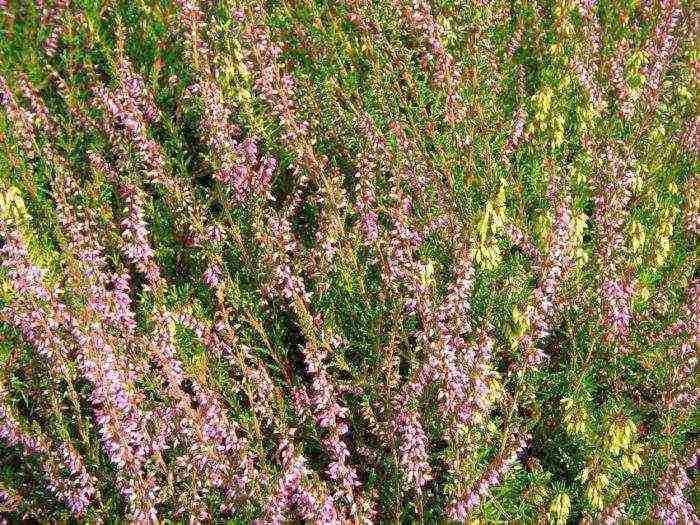 Marlin
Marlin
- David Eason... The height of the spherical bush is about 20 centimeters, and the diameter of its crown is 25 centimeters. There are a large number of ascending branches. The leaf plates are dark green. Lilac-pink dark flowers are part of the short brushes.
- Marlin... German variety.The bush reaches a height of about 0.3 m, and its crown diameter is 0.5 m. Dark brown bark, small dark green leaf plates. The mauve or deep purple buds never open.
Also popular are such varieties as: Romina, Minima, Fritz Kircher.
The beneficial properties of heather

Heather has medicinal properties that are used in both folk and traditional medicine. It is widely used in the treatment of cough, kidney disease, cystitis, pyelitis, urethritis, dysentery, diarrhea, gastritis, enterocolitis, rheumatism, gout, and skin diseases. Blooming heather is harvested from the last days of June to September, because during this period it contains the largest amount of useful substances: flavonoids, mineral salts of phosphorus, potassium, calcium and sodium, organic acids. Thanks to them, the plant has an antibacterial, anti-inflammatory, diaphoretic, wound healing, expectorant, diuretic, astringent, cleansing and sedative effect.
A decoction of this shrub is used for insomnia and disorders of the nervous system, for vascular atherosclerosis, diseases of the gastrointestinal tract, high acidity, cholecystitis and obesity. If the throat is inflamed or there is inflammation in the mouth, then the broth is used for rinsing. Alcohol tincture on this plant helps with tuberculosis. From the crushed flowers, a powder is made that helps with ulcers, eczema, wounds and burns. With sciatica, heather baths are taken. The infusion made from flowers is rubbed into the scalp, this helps to get rid of hair loss and improve their health.
Everyone can take heather, but nevertheless, before starting treatment with this plant, you should consult with an experienced doctor. It is better to refrain from ingesting medications made from heather for those who have low gastric acidity.
Heather bushes, when properly cared for, help create attractive forest carpets in a flower garden. This is a great design solution for those who like the naturgarden style. Here's what you need to do to make the heather blend in with your garden design.
Common heather (Calluna vulgaris) is an evergreen compact shrub (10-60 cm high), which adorns the garden with small white, yellow or lilac-pink flowers in late summer and early autumn. This attractive plant is used in folk medicine (mainly in the form of an infusion) as an anti-inflammatory, diuretic and antibacterial agent for cystitis, urolithiasis, gout, rheumatism and colds.
Single bushes do not look very impressive, so heather is often planted in large groups of simultaneously flowering varieties. In this case, plants can be of different colors.
Popular varieties of heather
Ornamental heathers can be planted in the garden in groups, depending on the height of the bushes.
Large heathers
These plants reach a height of 40-60 cm. Such varieties are good for creating multilevel compositions, where tall plants coexist with squat plants. Long White heather and carmine red Allegro and Annemarie are great for this role.
Medium heathers
Shrubs with a height of 30-40 cm are suitable for various compositions. Plants adorn rock gardens and rockeries, are used to create monochrome gardens in lilac-purple tones. The most popular varieties are Boskop (with lilac-pink flowers and light green leaves), Carmen (with pinkish-purple inflorescences) and Aurea (with delicate purple flowers and golden leaves, which acquire a terracotta hue in autumn).
Dwarf heathers
Miniature varieties do not rise more than 30 cm above the ground.They are best suited for creating heather fields. The mauve heather of Heidezwerg, the ruby-red Dark Star and Red Star, and the silver-violet Silver Knight are incredibly attractive.
Secrets of Successful Heather Planting
The shrub lives in one place for about 20 years, so the choice of the site should be approached responsibly. The first step is to choose a sunny spot in the garden. Heather tolerates partial shade, but then the plant has a more modest flowering.
In addition, the area must be protected from wind and water flooding. If necessary, drainage is placed on the site. Low-growing coniferous shrubs or small trees can be located next to the heather, as long as they do not block the light.
The site must be loose, breathable, acidic soil. Ideally, coniferous soil (semi-decomposed litter of a pine or spruce forest), which is taken from a depth of 5-7 cm.A mixture of high peat, coniferous soil and sand in a ratio of 3: 2: 1 is also suitable.
The best time to plant heather is late April to mid-May. During this period, the soil is saturated with moisture and the weather is quite warm, so the bushes take root well. Plants with a closed root system (in containers) can also be planted in summer, but in dry and hot weather they need to be carefully looked after: shade and water regularly. Heathers are planted in September, however, more delicate specimens risk not having time to settle down in a new place before the onset of cold weather.
The heather planting hole should be shallow (25-35 cm) but wide enough (about 40 cm). When planting several bushes, it is better to make a shallow pit and fill it with soil suitable for heather.
The heather is removed from the container, dipped into a container of water so that the earthy clod is saturated with moisture, then the plant is planted so that the bark neck is above ground level. Then the shrubs are watered abundantly.
If a whole meadow is planted with heathers, then first they place the bushes along its contour, and then fill the remaining voids so that there is the same distance between the plants.
Tall heathers are planted with 6-8 bushes per 1 sq. M, and low-growing ones - 12-15 pieces per 1 sq. M.
Heather care
All members of the Heather family have a superficial root system, so you need to be extremely careful when weeding. In order not to damage the roots, it is better not to loosen the soil around the heathers. To preserve moisture in the soil and reduce weeding, the bushes are mulched with dry peat, pine needles, chips or bark.
In summer, the mulch layer should be about 3 cm, and in late autumn and winter - 10 cm. In addition, for the winter, heather plantings are additionally covered with healthy oak leaves and spruce branches.
From May to autumn, heathers are regularly watered, but it is important not to flood the plants. Usually in the summer, 1-2 buckets of water are consumed for 5-7 adult bushes during the week. In dry season in the evening it is recommended to arrange sprinkling with water at room temperature. If the water is hard, it must be acidified. In this case, 1-2 days before watering, a little red peat is added to it and allowed to settle.
If you planted heather on suitable soil, then you do not need to feed the plant. When grown on depleted soil in spring, you can scatter granular Florovit fertilizer for rhododendron under the bushes. And keep in mind: fresh organic matter, ash, lime and chlorine are contraindicated for heathers.
Win-win heather flower garden design ideas
Heathers look great in homogeneous groups. When planting, plants of the same variety are used.
Planting in small islands of bushes of different shades is also good. So, lilac and purple heathers can be diluted with white ones, or you can add specimens with yellow-golden or silvery leaves to plants with the usual green leaves.
Heather is incredibly beautiful during mass flowering, and after winter, the bushes look inconspicuous and withered. Therefore, they should not be planted along the garden paths and near the main entrance.
Heathers are suitable for alpine slides, rockeries and perfectly decorate the shores of artificial reservoirs. Good neighbors for these shrubs will be creeping juniper, compact thuja, evergreen rhododendron, thyme, carnation grass.
Of course, these are not all of the uses for heather in landscaping. This delicate plant is often grown in containers or pots and made into a variety of compositions. Such heathers will decorate the window sills in the house, on the balcony or veranda.

